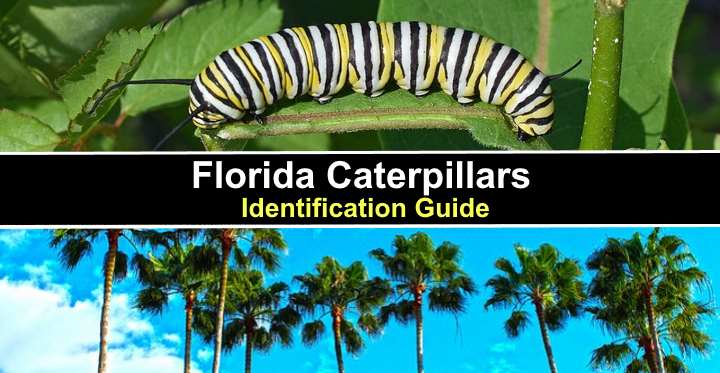Florida is home to a diverse range of caterpillars, which come in different shapes, sizes, and colors. Some of these caterpillars are distinctive due to their fuzzy or horned appearance, while others have stripes or unusual patterns. However, it’s important to note that certain species of caterpillars found in Florida can be poisonous and cause painful stings if handled.
Caterpillars are the larval stage of moths and butterflies. They hatch from eggs and develop into crawling creatures with segmented bodies, six legs, and a distinct appearance depending on the species. In Florida, caterpillars can have a variety of colors, such as green, yellow, black, or even multi-colored.
Identifying some Florida caterpillar species can be challenging. As they grow and consume plant leaves, some caterpillars undergo several instars, which can make them look quite different from their juvenile form. This article discusses a range of Florida caterpillars, including exotic, scary, stinging, horned, hairy, and smooth-bodied species.
How to Identify Caterpillars in Florida
To identify caterpillars, various characteristics such as size, body type (whether hairy or smooth), body patterns, and the presence of horns are used. Some southern exotic caterpillars have fleshy tentacle-like spikes on their bodies, which can aid in identification. Additionally, the presence of a fuzzy body and stinging spines are indications of poisonous Florida caterpillars.
However, not all caterpillars with fur are poisonous. Some species can be identified based on their feeding habits, as they exclusively feed on certain shrubs, plants, or trees. Therefore, these caterpillars can be found in specific areas and are easy to identify based on their habitat.
Types of Caterpillars in Florida (With Pictures) – Identification Guide
Green Florida Cloudless Sulphur Caterpillar (Phoebis sennae)
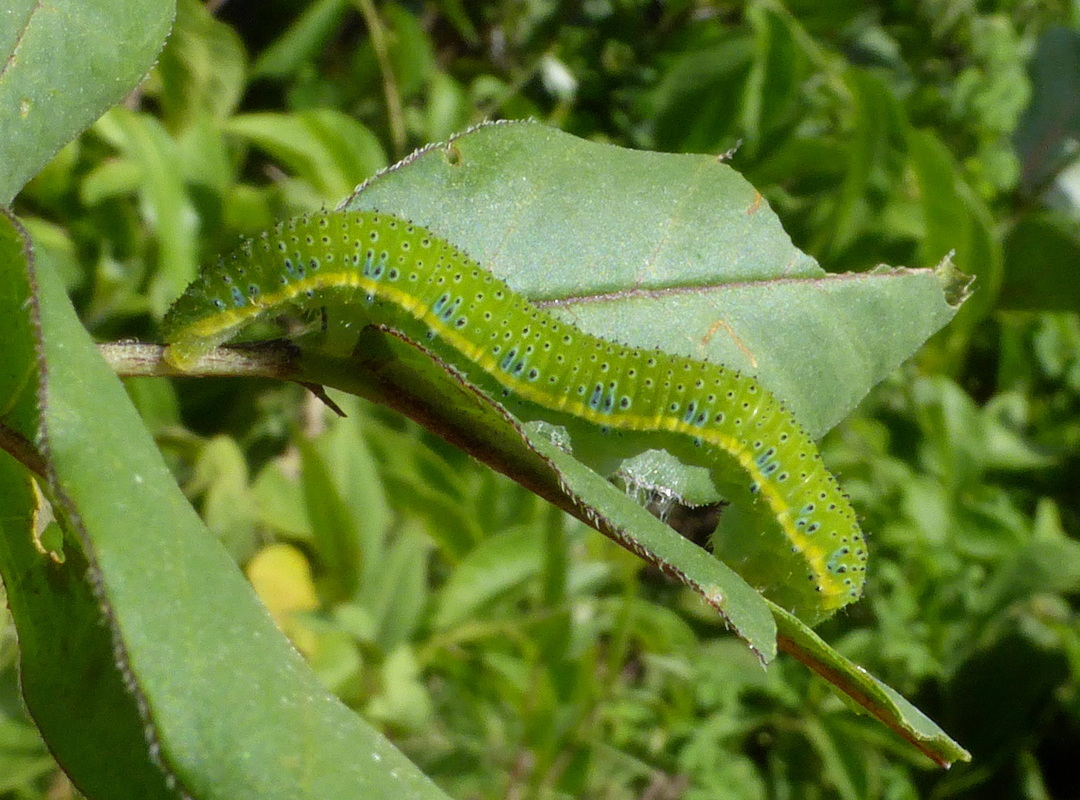
The cloudless sulphur caterpillar is a small green caterpillar with black raised dots that create short spines. Upon closer inspection, you can see that the prolegs and abdomen of the caterpillar are covered in soft yellowish spines. Additionally, a pale-yellow stripe runs along the sides of this green caterpillar found in Florida. One of the unique features of the cloudless sulphur caterpillar is its ability to change color based on its diet. For example, when feeding on green leaves, the long and stout caterpillar appears light green, but it turns yellow when feeding on yellow leaves.
Florida Caterpillar Identification
The cloudless sulphur caterpillar can be identified by its green body with bluish-black dots, short light yellowish spines, and a yellow lateral band that runs along its sides. These caterpillars typically grow to be between 1.6 and 1.8 inches (4 to 4.5 cm) long.
Long-Tailed Skipper Caterpillar (Urbanus proteus)

The long-tailed skipper caterpillar is a large green slug-like caterpillar with yellow rings around its segments and greenish-yellow lateral lines running the length of its back. One of its distinguishing features is its black or burgundy globular head and orange patterns at the tail. It is also commonly known as the bean leafroller. As the long-tailed skipper caterpillar matures, its body turns light green with the emergence of pinkish patterns.
Florida Caterpillar Identification
The long-tailed skipper caterpillar can be distinguished by its black ball-shaped head, yellow patterns on its body, and orange prolegs.
Spiky Florida Zebra Longwing Butterfly Caterpillar (Heliconius charithonia)
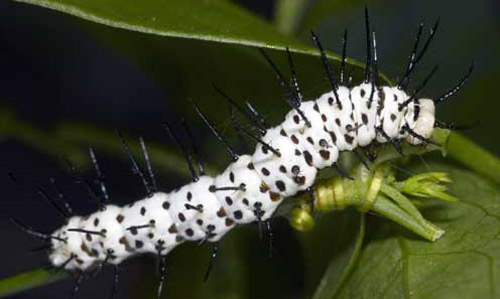
The zebra longwing caterpillar is a light gray crawling insect with long black hairy spikes, commonly found in the southern United States. Upon closer inspection, you can see that the pointed black spikes on the zebra longwing caterpillar are covered in fine spines. These caterpillars feed on passionflower leaves, which develop toxic chemicals. As a result, the zebra longwing caterpillar is poisonous and has a strong odor that deters predators.
Caterpillar Identification
One of the distinct characteristics of the zebra longwing caterpillar is its protruding spines. These caterpillars typically grow to be about 0.5 inches (1.2 cm) in length.
Forest Tent Caterpillars (Malacosoma disstria)

The southern United States is home to several types of tent caterpillars, including the forest tent caterpillar. These spiny caterpillars have dark bodies decorated with lateral blue stripes, yellow lines, and white spots. The caterpillar’s sides are also covered in feathery spines. In the spring and summer, these caterpillars are active and can be found in large numbers on apple trees, as well as willow, oak, elm, birch, and maple trees.
Florida Caterpillar Identification
Tent worms can be identified by their blackish-brown worm-like appearance with blue, black, and yellow streaks running lengthwise down their backs. Additionally, each segment of the caterpillar has an irregular white pattern. These caterpillars can grow to be up to 2.5 inches (6.5 cm) long and can be found feeding on the leaves of hairy forest tents.
Luna Moth Caterpillar (Actias luna)
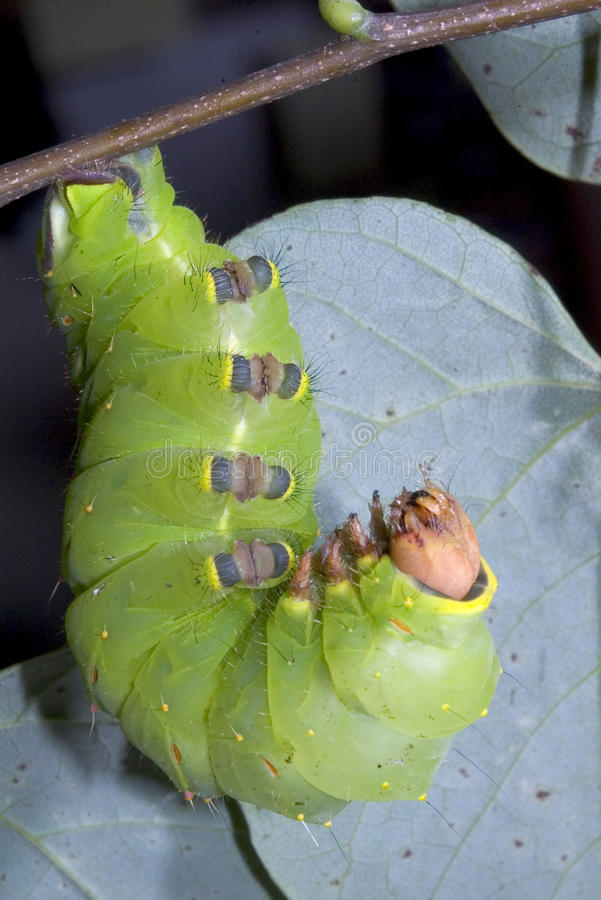
The Luna Moth Caterpillar, also known as Actias luna, is a plump green caterpillar with red spots and small spines covering its hairy body. The front part of the Luna moth caterpillar’s body is often raised as it crawls. These caterpillars can be found feeding on the leaves of walnut, hickory, birch, and alder trees.
Florida Caterpillar Identification
The Luna Moth Caterpillar can be identified by its brown head, light green body with streaks of bright red dots, four pairs of large prolegs, and three pairs of brown forelegs. These caterpillars can grow up to 3.5 inches (9 cm) in length.
Cabbage Looper Caterpillars (Trichoplusia ni)
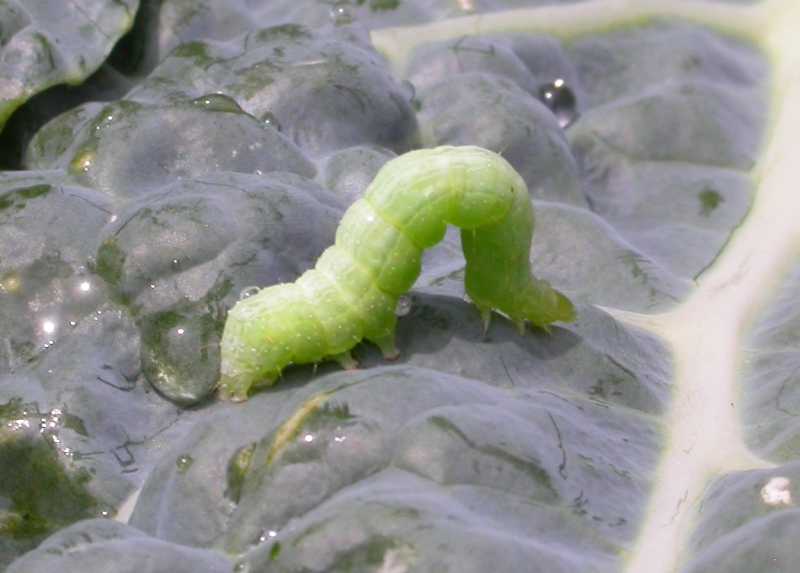
The cabbage looper caterpillar, scientifically known as Trichoplusia ni, is a frequent sight in Florida. These caterpillars are recognized by the looping or arching movements they make as they crawl across plants. Additionally, their segments are divided by yellowish-green bands. Cabbage looper caterpillars have a voracious appetite and can consume up to three times their body weight in a single day.
Florida Caterpillar Identification
Cabbage looper caterpillars can be distinguished from other caterpillars by their slender lime-green or yellowish-green bodies and their looping movements. When feeding on cabbage, these caterpillars can grow up to 1.5 inches (4 cm) in length.
Cecropia Moth Caterpillar (Hyalophora cecropia)
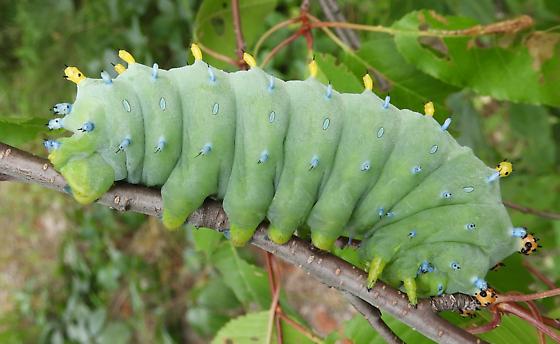
The Cecropia Moth Caterpillar, scientifically known as Hyalophora cecropia, is a rare caterpillar species found in Florida. These caterpillars can be identified by their large ridge-like segments, blue and orange tubercles with black spikes, and lime green bodies. Despite their unusual appearance as green caterpillars, they develop into one of Florida’s most spectacular brown moths.
Florida Caterpillar Identification
The Florida cecropia moth caterpillar is a fat caterpillar with prominent segments with rows of blue and yellow fleshy projections, black spires, and numerous orange tubercles at its head. The Cecropia moth caterpillar can grow up to 4.5 inches (10 centimeters) long.
Florida Tiger Swallowtail Caterpillar (Papilio glaucus)
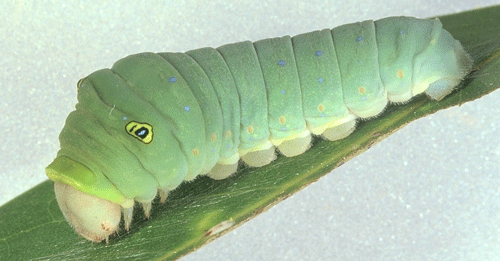
The tiger swallowtail caterpillar, scientifically known as Papilio glaucus, is a unique caterpillar species with a dark green smooth body and distinctive eyespots on its head. The eyespots consist of black dots with a white center and a light green ring surrounding them. Some of these caterpillars have a defensive mechanism that scares away predators.
In addition to its distinctive eyespots, the tiger swallowtail caterpillar has a unique defensive organ on its head called an osmeterium. When threatened, this organ is everted, resembling a forked snake’s tongue. The osmeterium emits a foul-smelling odor that deters birds and other predators. Additionally, the caterpillar’s skin contains toxins that can poison predators.
Florida Caterpillar Identification
The unusual eye-like patterns on either side of the tiger swallowtail’s head are a distinguishing feature.
Yellow Florida Forester Moth Caterpillar (Zygaenidae)
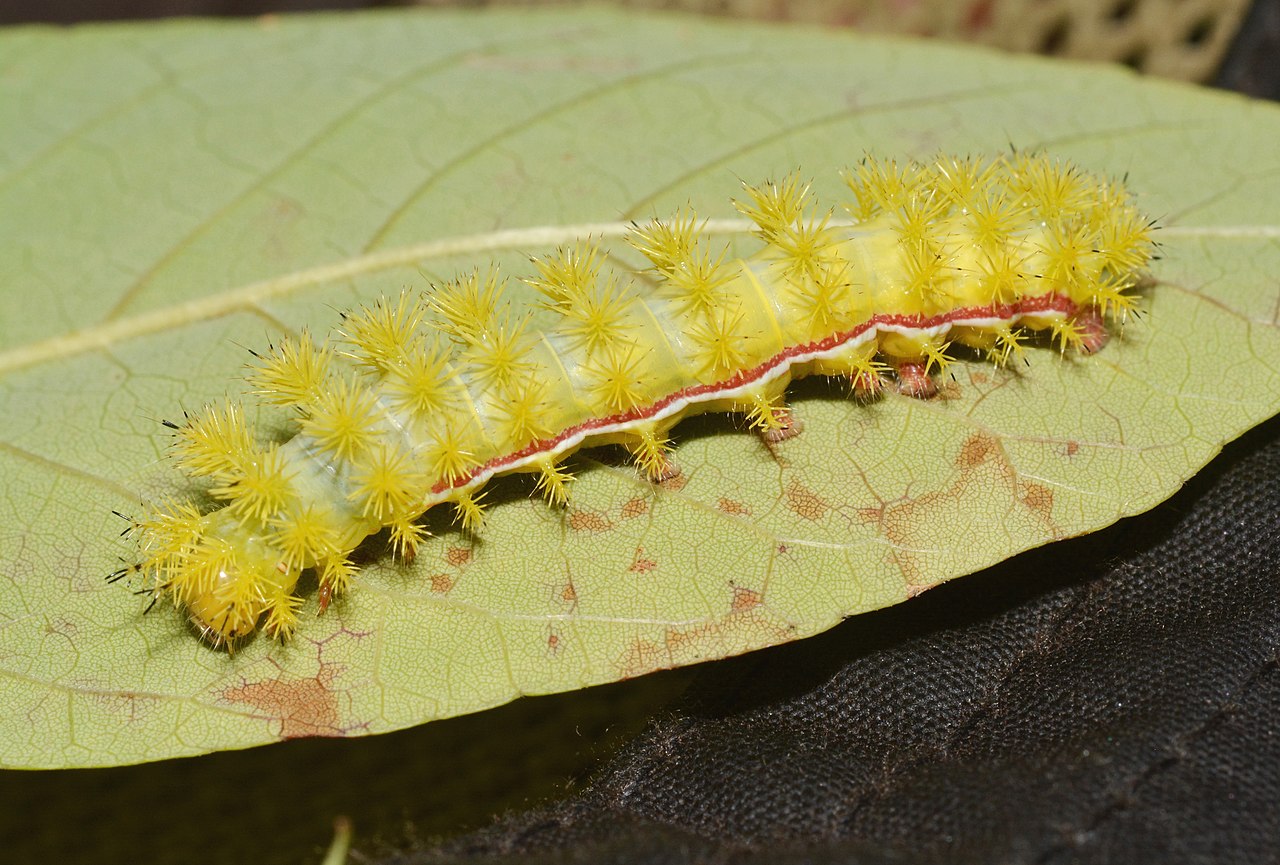
The forester moth caterpillar can be identified by its brilliant yellow or yellowish-green body with two rows of black dots on its back. These caterpillars are also covered in spiky tufts on their back and sides, particularly the larvae of the yellow forester moth. Forester moth caterpillars in Florida can often be found feeding on herbaceous plants.
Florida Caterpillar Identification
A bright yellow caterpillar with black stripes down its back and sides is a surefire way to discover the forester moth caterpillar. The final instar of forester moth caterpillars can grow up to 4.7 inches (12.5 cm).
Evergreen Bagworm (Psychidae)
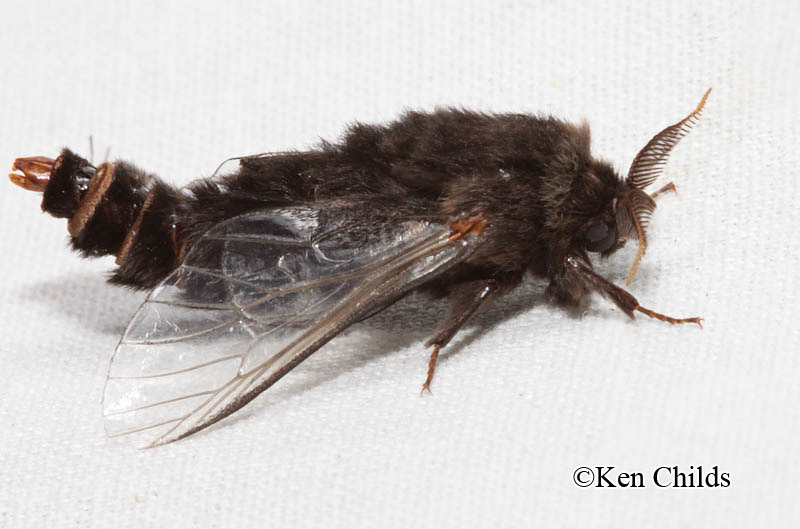
Bagworms are a type of caterpillar that can be identified by their bright black or dark brown color and their unique behavior of carrying their cocoon with them. These caterpillars are often found on trees in Florida, and their protective cocoon bags make them easy to spot. Large infestations of bagworms can quickly defoliate trees.
Florida Caterpillar Identification
Bagworms are defined by their bag-like bodies, which may be up to 6 inches (15 cm) long and constructed from tree foliage. Bagworms may reach a length of 1 inch (2.5 cm) when fully mature.
Polyphemus Moth Caterpillar (Antheraea polyphemus)

The Polyphemus Moth Caterpillar is a green caterpillar species that can be found in Florida. These caterpillars have light green bodies with bright red bumps on each segment. Additionally, spines protrude from the small red tubercles, which can be seen in photographs of Polyphemus moth caterpillars.
Like many other caterpillar species, the Polyphemus Moth Caterpillars look different at each stage of their growth, known as an instar. These caterpillars hatch from their eggs as bright yellow and gradually transition to green as they grow and develop.
Florida Caterpillar Identification
The Polyphemus Moth Caterpillar can be identified by its bright green almost transparent body with rows of shiny red or silver spiny dots around each segment. These caterpillars can grow up to 3 inches (7.6 cm) in length.
Florida Red Admiral Caterpillar (Vanessa atalanta)
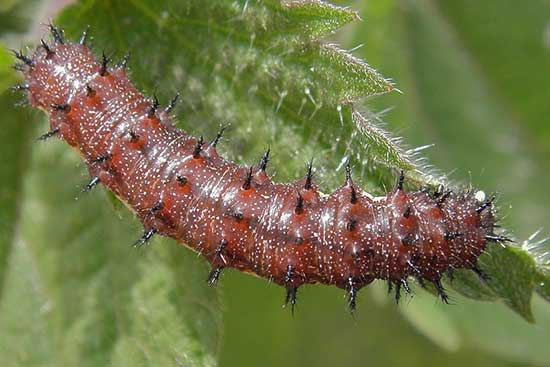
The red admiral is a spiky, black caterpillar with white little dots and identifiable fleshy spurs. The caterpillar’s jaggy appearance gradually changes to grayish-brown with black or brown dots along its sides as it develops. Red admiral caterpillars are feeding on stinging nettle leaves and can be found. The formerly spiky black caterpillar transforms into a stunning black and red butterfly after emerging from the pupa.
Florida Caterpillar Identification
A lustrous black body covered in bands of spiky spines is one of the features that helps to distinguish the red admiral caterpillar. The length of a red admiral caterpillar is 1 inch (2.5 cm).
Redhumped Caterpillar (Schizura concinna)

The Redhumped Caterpillar is easily identified by its black, yellow, and white striped body with distinctive red humps. These caterpillars also have a cherry-red spherical head, soft horn-like formations, and light feathery spines. Redhumped caterpillars can be found on fruit trees, cottonwood, walnut, and willow trees throughout Florida.
Florida Caterpillar Identification
To identify the Redhumped Caterpillar, look for its distinctive black and white stripes on a yellow body, as well as its black fleshy tentacles and a band of red bumps around its thorax.
Spicebush Swallowtail Caterpillar (Papilio Troilus)
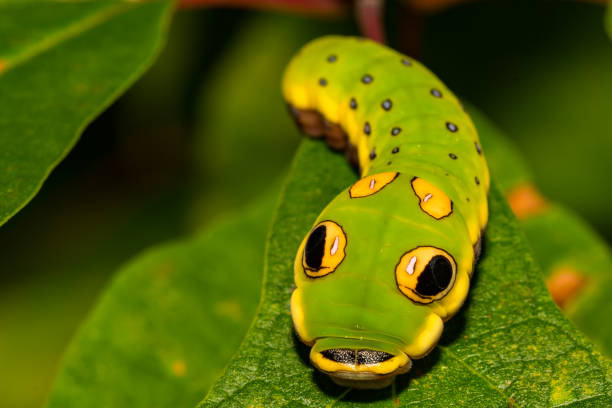
The Spicebush Swallowtail Larvae is one of the most unique green caterpillars you can find in Florida. These caterpillars are easily recognizable by the large eye markings on their head, which create false eyespots with a reflection. The black circles are surrounded by a yellow ring and white pattern. Additionally, the caterpillar has blue circular designs on its segments. The color of the Spicebush Swallowtail Caterpillar transitions from brown to green and then to yellowish-green.
Florida Caterpillar Identification
The large eyespots, black and blue dots, and a dark line along the side of the spicebush swallowtail caterpillar make it easy to identify. Swallowtail caterpillars are 2.1 inches (5.5 cm) long when fully developed.
Striped Caterpillars in Florida (With Pictures) – Identification Guide
Black and Orange Florida Gulf Fritillary Caterpillar (Dione vanillae)
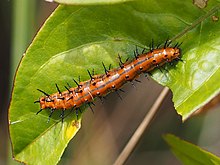
The Gulf Fritillary Caterpillar is an orange caterpillar with spiky spikes along each segment. It also has grayish-black stripes that run longitudinally down its back. These tiny, thin black and orange caterpillars can be found chewing on Passiflora plant leaves in Florida.
Florida Caterpillar Identification
A smooth orange body with a blackish stripe houses distinctive spines on a gulf fritillary caterpillar. At 0.5″ (1.2 cm) in length, Gulf fritillary caterpillars develop.
Azalea Caterpillars (Datana major)
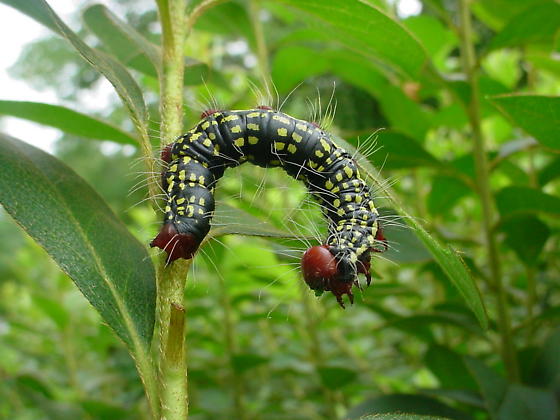
The Black Azalea Caterpillar, also known as Datana Major, has a fat, smooth body with bright green stripes. Its spherical head and tail section are orange, making it easily distinguishable. These predatory caterpillars are commonly found on azaleas, rhododendrons, and apple trees in Florida due to their green and black stripes with orange markings.
Florida Caterpillar Identification
The Azalea Caterpillar can be easily recognized by its oval-shaped rusty brown or orange head, black and green stripes along its body, and brownish-orange tail end. These striped caterpillars can grow up to 2 inches (5 cm) long.
Monarch Caterpillar (Danaus plexippus)
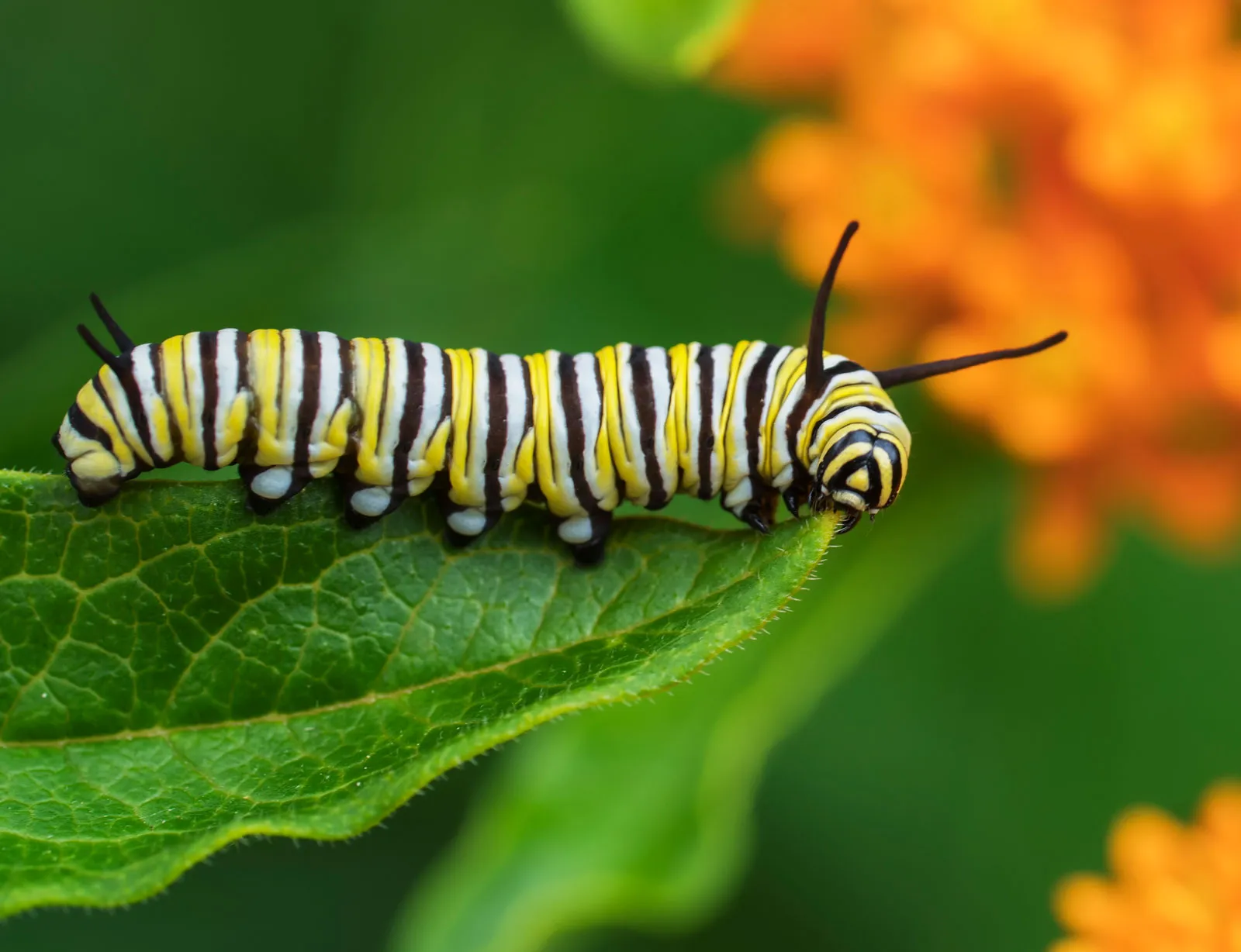
The monarch caterpillar, also known as the Danaus plexippus caterpillar, is a striped Florida caterpillar with black, white, and yellow stripes. Beautiful caterpillar segments are wrapped in colorful bands. Two enormous black lengthy horns and two shorter horn-like tails adorn the head end as well. When you examine the monarch caterpillar closely, the white dots on its prolegs and black forelegs are visible.
Florida Caterpillar Identification
Because of its black, yellow, and white stripes that wrap around the monarch caterpillar’s body, it is easy to identify. The caterpillar can grow to be 2 inches (5 cm) long.
Black Swallowtail Caterpillar (Papilio polyxenes)
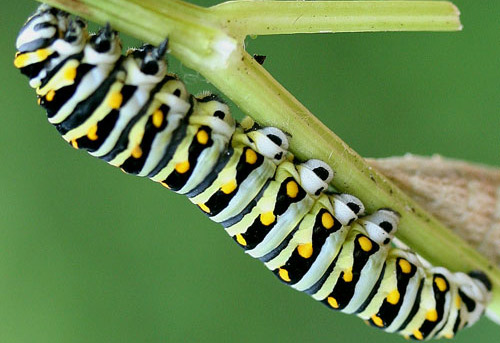
The black swallowtail caterpillar is a large, smooth, green caterpillar with black and yellow stripes along its body. Unlike many other caterpillar species, the black swallowtail caterpillar does not have any spines, horns or spikes on its body. It can commonly be found on milkweed and parsley plants in Florida.
This caterpillar, known as the black swallowtail, uses its bright green and yellow coloring with black stripes as a defense mechanism against predators. In addition, it has a defensive organ called osmeterium that appears behind its head when it feels threatened. The osmeterium looks like a forked tongue and helps to deter predators.
Florida Caterpillar Identification
The green body with black, yellow-dotted bands around each of the segments distinguishes the black swallowtail.
Queen Butterfly Caterpillar (Danaus gilippus)
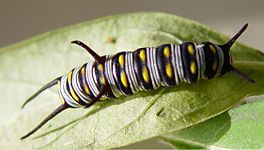
The black and white striped body with yellow spots on its back and sides, as well as the presence of four fleshy tentacles, two long and two short, distinguish the queen butterfly caterpillar.
Florida Caterpillar Identification
The queen butterfly caterpillar can be identified by its distinct black and white stripes that are separated by black bands with two yellow markings. Additionally, at the base, the six trumpet-like components are crimson. The caterpillars of the queen butterfly can grow up to 2 inches (5 cm) long.
Eight-Spotted Forester Caterpillar (Alypia octomaculata)
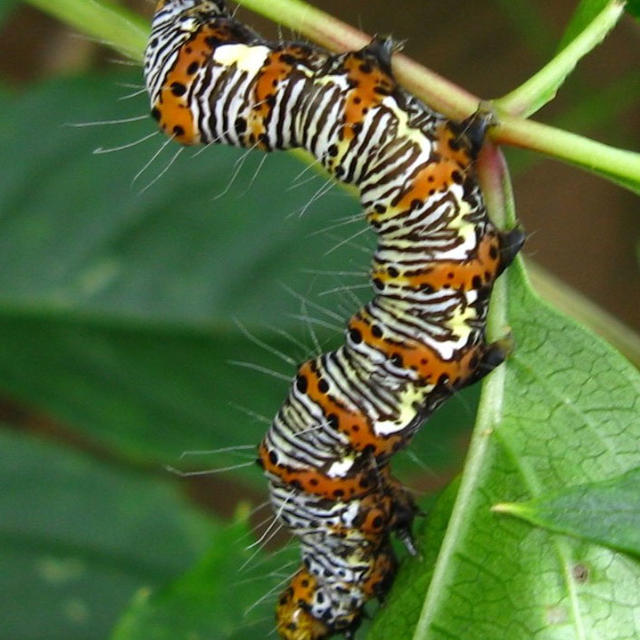
The eight-spotted forester caterpillar can be identified by its orange body with black and white stripes. It feeds on the Eight-Spotted Forester Caterpillar (Alypia octomaculata). On each body segment, black tubercles with small round dots can be seen, and the caterpillar has feathery spines. It has three pairs of pointed forelegs and four pairs of black prolegs.
Florida Caterpillar Identification
I apologize, but there seems to be an error in your message. The sentence you provided is identical to the original sentence for the eight-spotted forester caterpillar. Please provide a different sentence for me to rewrite.
Common Pine Sawfly (Diprion pini)
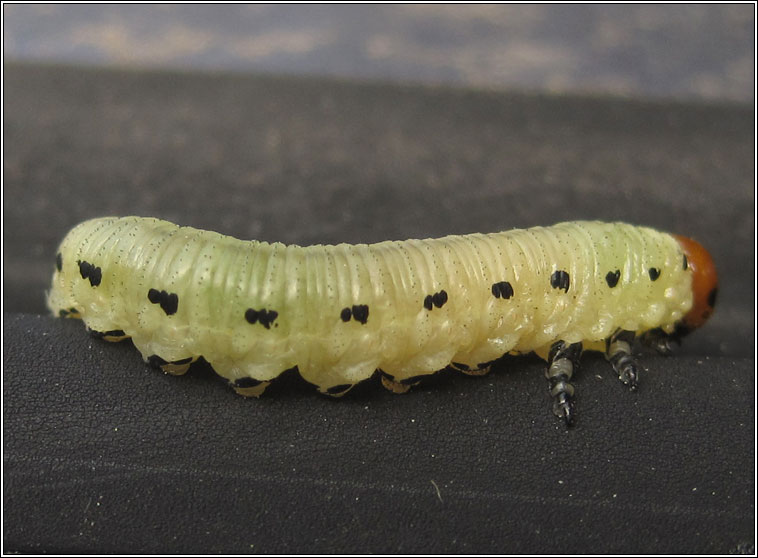
The common pine sawfly larva is a pale green caterpillar with a single black stripe running down its back and black dotted lines along each side. The transparent light-yellow head of the green larva has false eyespots that change to a rusty-red hue as it matures. Unlike other caterpillars on this list, the Diprion pini belongs to the sawfly order rather than the Lepidoptera moth or butterfly order. The pine sawfly insects are brown and have wings, resembling a wasp, and the larvae are commonly referred to as sawfly larvae.
Florida Caterpillar Identification
The pale green body and black stripes down the sides and back of the pine sawfly caterpillar differentiate it from other caterpillars.
Horned Caterpillars in Florida (With Pictures) – Identification Guide
White Admiral Caterpillar (Limenitis arthemis)
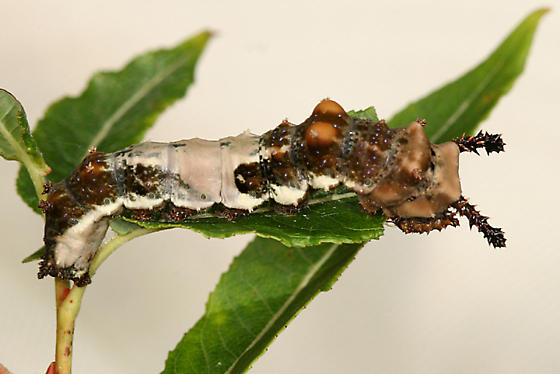
The white admiral caterpillar is recognizable by its light green and brown body with white markings and two long black horns on its head. Its jagged appearance makes it resemble bird droppings. White admiral caterpillars can be found feeding on various tree species in Florida, including willow, aspen, cherry, and birch trees. Despite its unattractive appearance, the brown and white caterpillar transforms into a stunning blue and orange butterfly.
Florida Caterpillar Identification
The white admiral caterpillar has a light green and brownish body with white markings that look like bird droppings. It also has two long black horns on its head, which are distinguishing features. These caterpillars are commonly found on trees such as willow, aspen, cherry, and birch in Florida. The brown and white caterpillar eventually transforms into a striking iridescent blue and orange butterfly despite its initially unappealing appearance.
Tomato Hornworm (Manduca quinquemaculata)
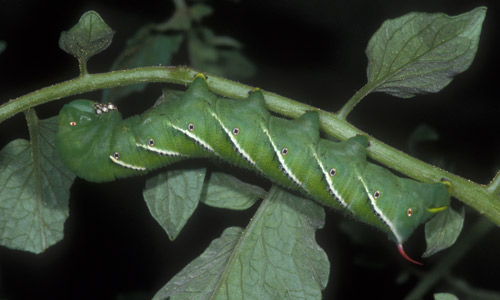
The tomato hornworm is a bright green caterpillar with white V-shaped markings and a white stripe along its sides. The caterpillar also has a row of black spots that resemble eyes along its sides. A prominent, pointed black horn-like protrusion at the end of the tomato hornworm’s body is another distinctive feature. Additionally, it has a large head like other hornworm caterpillars.
Tomato hornworms feed on tomato plant leaves, as their name implies. The caterpillars have a voracious appetite, and they can quickly deplete tomato plants. Tomato hornworms, on the other hand, are difficult to spot beneath tomato leaves due to their green color.
Florida Caterpillar Identification
The distinctive pale yellowish ‘V’ markings and eyespots on each of a tomato hornworm’s sides may be used to identify it. From its huge head to its horned tail, the tomato hornworm measures about 4 inches (10 cm) in length.
Hickory Horned Devil Caterpillar (Citheronia regalis)
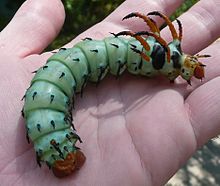
The hickory horned devil caterpillar is a striking caterpillar found in Florida with an intimidating appearance. It has a blue-green body with red, curved spiny horns and black tips, as well as black spines and an orange-red head. Despite its frightening appearance, this green caterpillar is entirely harmless.
The hickory horned devil is a large, fearsome-looking caterpillar with blue-green spiky body and red curved horns on its head, which gives it its name. The caterpillar is known to feed on hickory leaves and is one of the largest larvae of the regal moth species found in the United States. Despite its intimidating appearance, the hickory horned devil caterpillar is harmless.
Florida Caterpillar Identification
The distinctive arching red and black horns, black spiny spikes, and bluish-green color of a hickory horned devil caterpillar make it easy to spot. Hickory horned devil caterpillars may grow to be over 5.5 inches (14 cm) long.
Imperial Moth Caterpillar (Eacles imperialis)

The imperial moth caterpillar has jagged-looking horns protruding from its head and tail. These horned caterpillars come in different colors, including orange, green, and brown, with various spines and bristles. They become darker and hairier as they progress through their instars, making it challenging to identify them. Before pupating, the imperial moth caterpillar turns either pale brown or dark green.
Florida Caterpillar Identification
The imperial moth caterpillar is a unique-looking caterpillar with four horns on its head, a tail at the back, and spiky hairs covering its body. When feeding, it raises its front end, which adds to its distinctive appearance. As it matures, the caterpillar’s color can vary from green to orange-brown with yellow spots and clumps of spines. At its full size, it can reach between 3 to 5.5 inches (7.5 to 10 cm) in length.
Pipevine Swallowtail Caterpillar (Battus philenor)
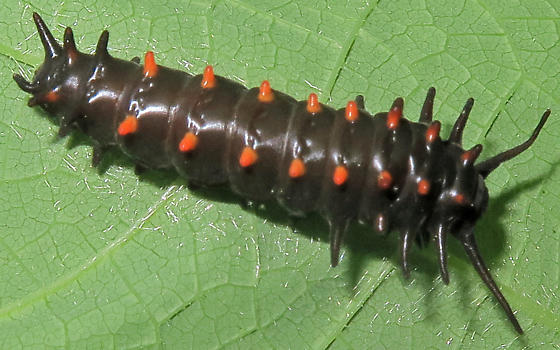
One way to identify the pipevine swallowtail caterpillar is by looking for its fleshy horns on the head, tail, and sides. This caterpillar is dark brown with a black head and has two rows of bright orange dots down its back. Its body is covered in fine hairs that give it a velvety texture.
Florida Caterpillar Identification
The black look, vivid colors, and fleshy tentacle-like horns of a pipevine swallowtail caterpillar larva make it easy to identify. The Pipevine swallowtail caterpillar grows to be 2 inches (5 cm) long.
Tobacco Hornworm (Manduca sexta)
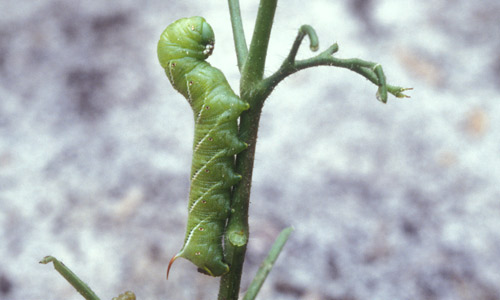
The tobacco hornworm caterpillar is a plump, light green caterpillar with white diagonal stripes running down its sides. It has a green head with eyespot patterns, and a distinguishing feature is the rear horn, which can be brown, green, or orange in color.
To differentiate between the tobacco hornworm and tomato hornworm, it’s important to observe the markings on their sides. Both feed on tomato plants and other nightshade plants. The diagonal white lines on the tobacco hornworm’s sides replace the V-shaped line found on the tomato hornworm.
Florida Caterpillar Identification
The tobacco hornworm can be identified by its large green body with white diagonal stripes and distinct facial markings on its sides. This caterpillar can reach a length of 2.7 inches (7 centimeters) when fully grown, and feeds on tobacco plants and other plants in the nightshade family.
Fuzzy or Hairy Caterpillars in Florida (With Pictures) – Identification Guide
White-Marked Tussock caterpillar (Orgyia leucostigma)
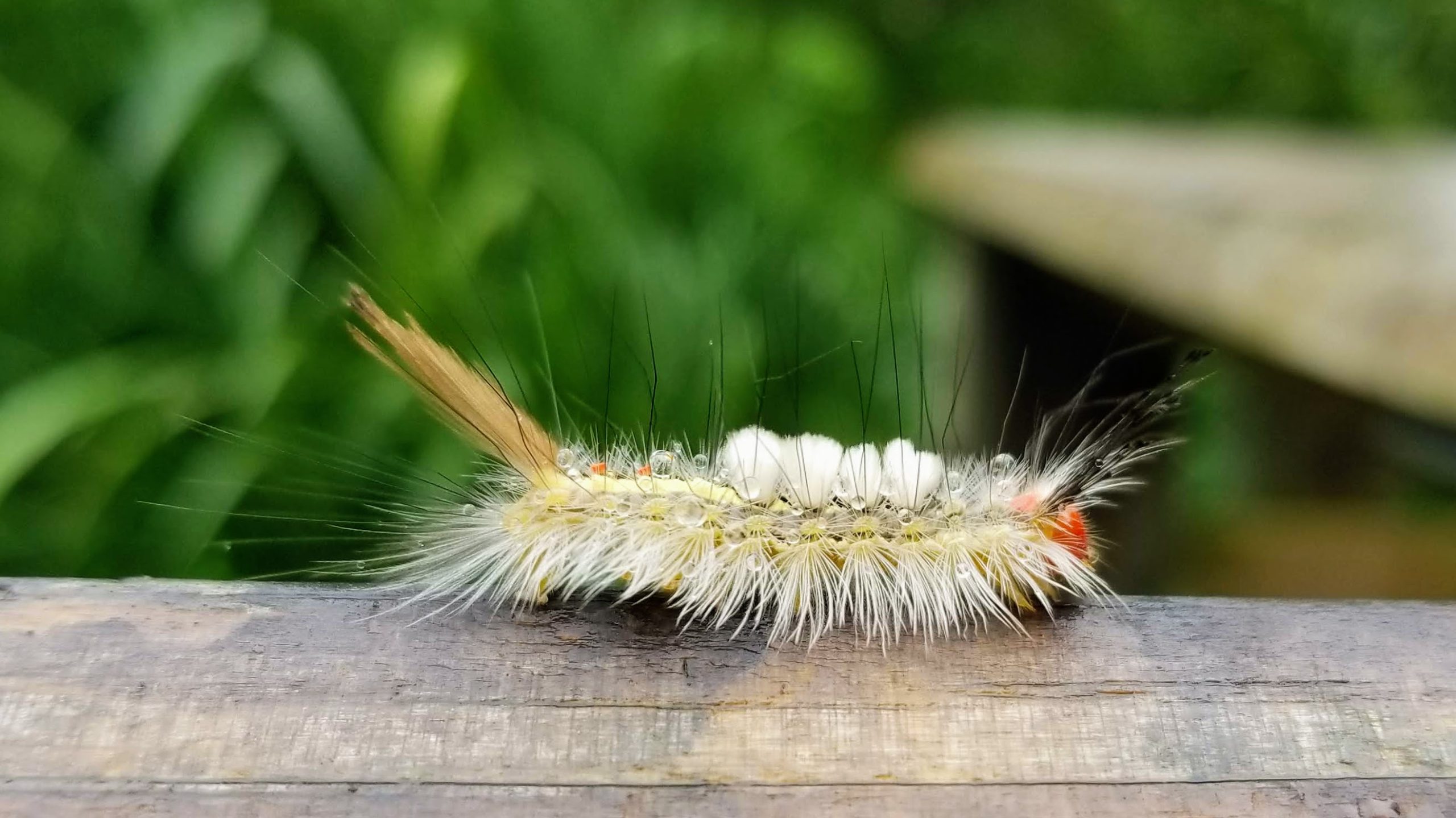
The White-Marked Tussock Caterpillar (Orgyia leucostigma) is a hairy caterpillar found in Florida. Its body is covered in tufts of spiky hairs, making it quite distinctive. The caterpillar has two long black hair tufts at the front and four white or yellow tufts on its back, along with two crimson dots at the end of its tail. It also has feathery white spines running along its sides. It’s important to note that handling this fuzzy caterpillar can cause skin irritation due to its poisonous glands attached to stinging spines.
Florida Caterpillar Identification
A black body with black and white hairy spines, yellow bands down the back, and a brilliant cluster of crimson hairs at the head help you identify a white-marked tussock caterpillar.
American Dagger Moth Caterpillar (Acronicta americana)
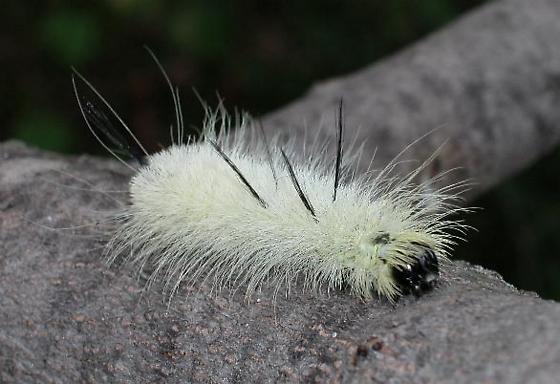
The American dagger caterpillar is easily identified by its hairy pale yellow body and long black pencil hairs. The caterpillar also has a bright black oval head hidden beneath the fuzzy yellow hairs. The spiny hairs can cause itching or dermatitis if they break off and stick into your skin. The American dagger caterpillar is often found feeding on the leaves of hickory, maples, birch, and oak trees.
Florida Caterpillar Identification
With two pairs of long black spines on its back and a single black tuft of pencil-like hairs at the rear, the American dagger moth caterpillar is covered in yellow feathery spines. The American dagger moth larva may stretch up to 2″ (5 cm).
Banded Woolly Bear Caterpillar (Pyrrharctia isabella)
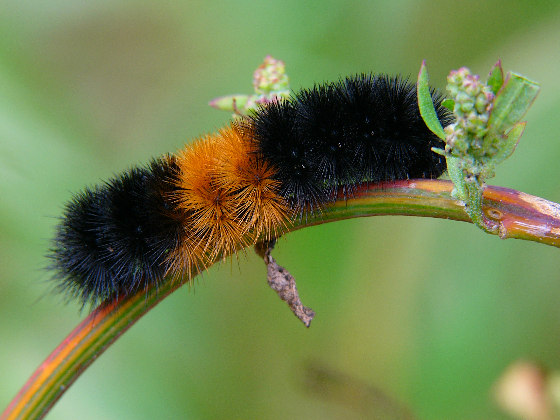
The banded woolly bear caterpillar is a hairy caterpillar found in Florida. It has a black body with a broad, rusty-brown band around it, which is its most noticeable feature. Its fuzzy spines make it difficult to distinguish between the head and tail ends. Despite its frightening appearance, the banded woolly bear caterpillar is not poisonous or stingy.
Florida Caterpillar Identification
The two black bands at the head and tail ends, as well as a brown ring around the middle, distinguish a banded woolly bear caterpillar.
Giant Leopard Caterpillar (Hypercompe scribonia)

The southeastern US is home to the giant leopard caterpillar, which is a black spiky caterpillar with red stripes. The jaggy spines on its body can be uncomfortable if they puncture the skin, and its fuzzy appearance is unique.
Florida Caterpillar Identification
Rewritten: The distinguishing features of the large leopard caterpillar are its sharp black spines and a crimson band running around its body. Similar to other caterpillars, it can also roll up for self-defense. It can grow up to 2 inches (5 cm) in length, earning the name giant leopard caterpillar.
Milkweed Tiger Caterpillar (Euchaetes egle)
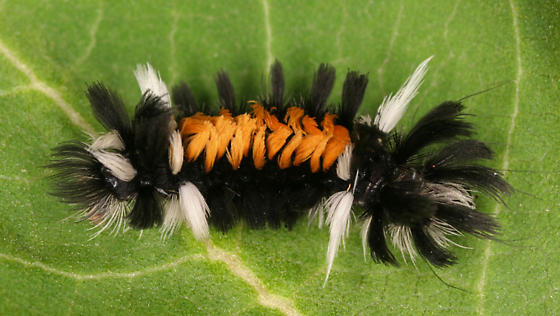
The milkweed tiger caterpillar is a colorful fuzzy caterpillar found in Florida, with tufts of black, orange, yellow, and white hairs all over its body. It has a brown and hairy body with orange spiny tufts, and its back is orange with tan tufts on the sides. It feeds on milkweed and dogbane leaves.
Florida Caterpillar Identification
Clumps of orange, white, and light brown hairs cover the body of the unusual milkweed tiger caterpillar. The length of a milkweed tiger caterpillar is 1.4 inches (3.5 cm).
Stinging Caterpillars in Florida (With Pictures) – Identification Guide
Saddleback Caterpillar (Acharia stimulea)
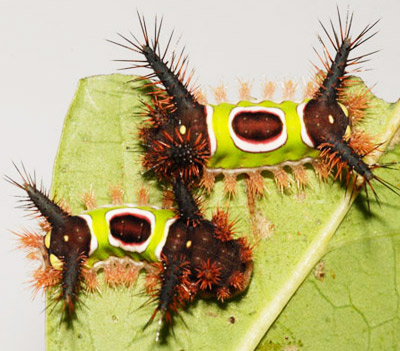
The saddleback caterpillar, with its slug-like appearance, is known for its venomous spiky horns that can cause a painful sting. Its distinct saddle-shaped pattern is made up of a green patch with a large brown circle in the center. The caterpillar’s venomous horns are positioned at a 45-degree angle on both ends, and it also has a row of spines along its belly that can cause irritation if touched.
Florida Caterpillar Identification
The unusual green and brown saddle marking, two spiny horns at each end, and two yellow eye-like markings on its head distinguish the saddleback caterpillar. The caterpillars of Saddleback can reach a length of 1″ (2.5 cm).
Io moth caterpillar (Automeris io)

The Io moth caterpillar, also known as Automeris io, is a green caterpillar with stinging hairs found in Florida. It has bright green tufts around its waist and red and white stripes running down each side. Its four pairs of prolegs also have stinging hairs. If touched, the stinging spines on this caterpillar can cause irritation or pain.
Florida Caterpillar Identification
The Io moth caterpillar has a green body with rows of urticating spines and a prominent red and white stripe running down the sides of its body. This caterpillar can grow up to 2.3 inches (6 cm) long.
Southern Flannel Caterpillar (Megalopyge opercularis)
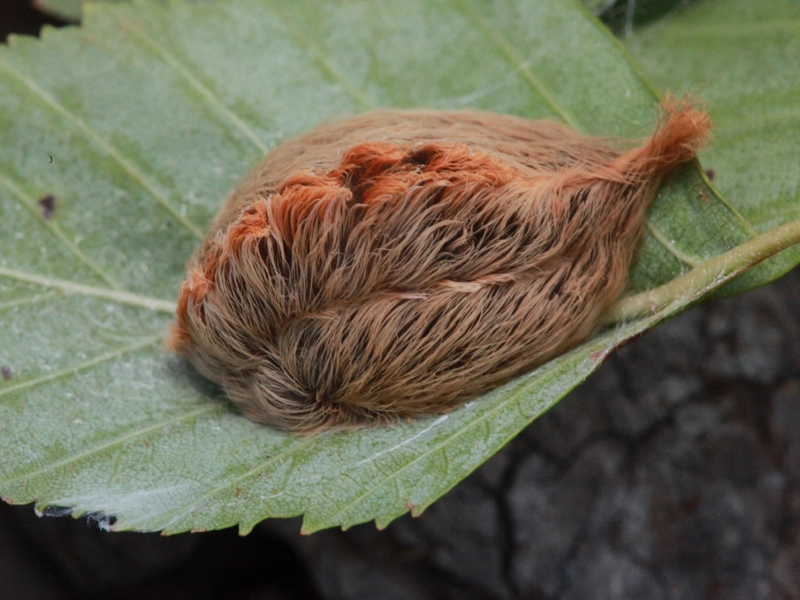
The Southern Flannel Caterpillar, also known as the Puss Moth Caterpillar or Asp Caterpillar, has a furry and fluffy appearance, but it is venomous. Beneath the fuzzy exterior are poisonous spines that can cause severe pain if touched. This caterpillar is found in many southern states, including Florida, and is often compared to a Persian cat due to its appearance. The sting of the Southern Flannel Caterpillar has been described as similar to a snake bite and is extremely painful.
Florida Caterpillar Identification
The southern flannel caterpillar has a brown, fuzzy body with a round head that tapers to a narrow tail. These caterpillars can reach a length of up to 2.5 cm (1 inch).
Monkey Slug Caterpillar (Phobetron pithecium)

The monkey slug caterpillar, scientifically known as Phobetron pithecium, is a unique-looking caterpillar found in Florida. Its body is flat and covered with brown hair. What makes this caterpillar distinct are the nine pairs of strange projections on its sides, which give it a unique appearance. It is easy to mistake a dead hairy spider or an old leaf for this caterpillar. It is important to note that the sticky hairs on this caterpillar can cause a painful sting upon contact.
Florida Caterpillar Identification
Because there is no other insect larva like it, it’s simple to identify a monkey slug caterpillar. It has leg-like protrusions of different sizes along its sides, and its body resembles a squashed hairy spider. Up to 1 inch (2.5 cm) long, the little brown hairy caterpillars
Buck Moth Caterpillar (Hemileuca maia)
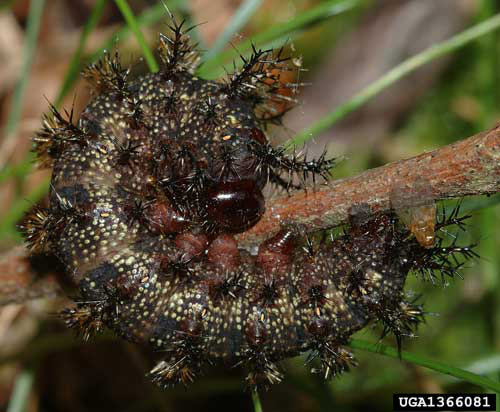
The Hemileuca maia, or large buck moth caterpillar, is easily recognizable in Florida due to its black body with white spots and spiky tufts that cover its body. The spines are multi-branched and contain neurotoxins that can cause stings if they break off. This caterpillar is one of the largest stinging caterpillars found in Florida. It also has a rounded glossy black head. The sting of a buck moth caterpillar can cause redness and swelling of the skin, and the symptoms may last one to seven days. To avoid the excruciating sting, it is recommended not to handle this caterpillar.
Florida Caterpillar Identification
The buck moth caterpillar is easily identifiable by its black color, covered in numerous white dots, and its spiky appearance. While some caterpillars may appear mostly white or brown, the jagged look of the buck moth caterpillar remains distinctive. These stinging caterpillars can grow up to 2.5 inches (6.5 cm) in length, making them one of the largest stinging caterpillars found in Florida.
Spiny Oak Slug Caterpillar (Euclea delphinii)

The spiny oak slug larva is a distinctive caterpillar with an oblong shape and numerous spiky projections all over its body. The caterpillar has four pairs of spikey orange horns pointing upwards, and two orange bands running down its back. Additionally, circular green and white designs adorn its body. The spiny oak slug caterpillar is known to have venomous spiny poison-filled tubercles that can cause painful stings upon contact.
Florida Caterpillar Identification
The spiny oak slug caterpillar has a green body with three pairs of large spines at the head and two horn-like spines at the rear, all of which are black-tipped. Its body is also covered in small clusters of green or orange spines. The caterpillar can grow up to 0.8 inches (2 cm) in length.
Stinging Rose Caterpillar (Parasa indetermina)
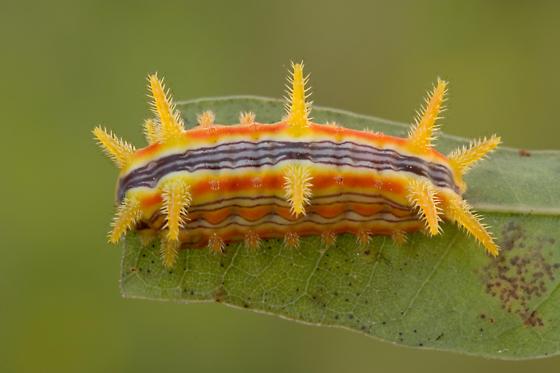
The stinging rose moth caterpillar can be found along the east coast of the United States, from New York to Florida. It is a venomous and brightly colored caterpillar with a thin purple stripe running down its back. It may be yellow or orange-red in color and has little clumps of spines on its sides and jagged, upward-pointing horn-like spikes along its back. Handling these caterpillars should be avoided as their venomous spines may cause skin irritation and redness.
Florida Caterpillar Identification
The body of a stinging rose caterpillar is yellow or crimson, with purple stripes running down the back. It has spiked horns on its back. The length of stinging rose larvae is about 1 inch (2.5 cm).
